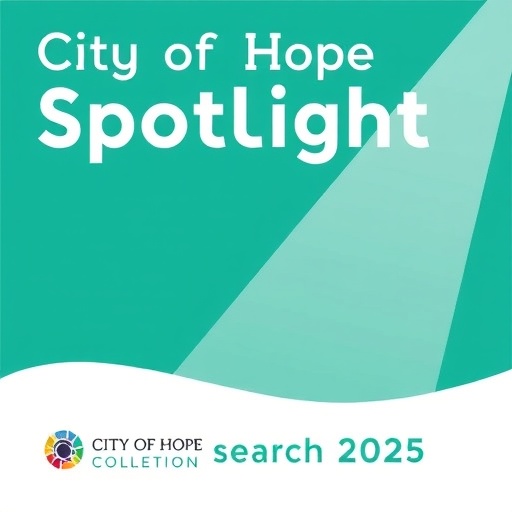
City of Hope’s latest research compendium shines a spotlight on transformative scientific advancements and clinical breakthroughs across cancer, diabetes, and other chronic life-threatening diseases. As a leading institution at the forefront of biomedical innovation, City of Hope continues to push the boundaries of medical science, translating laboratory insights into life-saving therapies. This comprehensive overview delves into cutting-edge studies ranging from the intricate cellular mechanisms underpinning type 1 diabetes to pioneering liquid biopsy technologies that predict responses to targeted cancer therapies.
Over the past decade, the Human Islet Research Network (HIRN), established by the National Institute of Diabetes and Digestive and Kidney Diseases in 2014, has made substantial strides in unraveling the complexities of type 1 diabetes pathogenesis. Spearheaded by City of Hope’s John Kaddis, the interdisciplinary HIRN consortium has developed innovative in vitro and in vivo systems that elucidate beta cell behavior within their native microenvironment. These advances allow scientists to model disease progression more accurately, employing novel technologies to dissect beta cell loss, immune interactions, and mechanisms of cell replacement. Despite these advancements, critical gaps remain in understanding the precise triggers for autoimmune beta cell destruction and how best to intercept these processes before the onset of clinical disease. The network emphasizes shared data platforms and collaborative training to foster cross-disciplinary solutions aimed at preventing and ultimately curing type 1 diabetes.
Emerging epidemiological evidence highlights the impact of obesity on multiple myeloma progression, particularly in individuals with the precursor lesion monoclonal gammopathy of undetermined significance (MGUS). Research led by Lawrence Liu at City of Hope meticulously analyzed longitudinal body mass index (BMI) data from nearly 22,500 MGUS patients to quantify the risk attributed to sustained elevated BMI. Their findings reveal a compelling correlation between prolonged exposure to overweight or obese BMI ranges and an increased likelihood of progression to full-blown multiple myeloma. Participants maintaining a BMI above 25 after diagnosis demonstrated a significantly elevated risk of malignancy evolution, underscoring the crucial importance of weight management in mitigating cancer risk. This study represents a paradigm shift in recognizing metabolic factors as modifiable determinants in hematologic cancer progression.
In the realm of metastatic colorectal cancer (mCRC), precision medicine continues to evolve with sophisticated biomarker-driven approaches to guide therapeutic decisions. Investigators at City of Hope, led by Ajay Goel, validated a revolutionary liquid biopsy platform known as EXONERATE to predict patient responses to epidermal growth factor receptor (EGFR) inhibitors, specifically panitumumab and cetuximab. Employing genome-wide small RNA sequencing of circulating exosomes and cell-free microRNAs, the assay identifies molecular signatures indicative of therapeutic efficacy. Crucially, this technology accounts for tumor heterogeneity associated with primary tumor sidedness, a known determinant of EGFR inhibitor response. The assay demonstrated robust predictive value for progression-free and overall survival across diverse patient populations, offering an unprecedented non-invasive tool for real-time treatment stratification in mCRC management.
Immune checkpoint blockade has transformed oncologic care, yet the heterogeneity of patient response remains a formidable challenge. Targeting this, Kelly Mahuron and colleagues at City of Hope embarked on an intricate molecular characterization of tumor infiltrating lymphocytes (TILs) within advanced melanoma samples to identify biomarkers predictive of anti-PD-1 antibody efficacy. Their seminal work employing single-cell RNA sequencing delineated a unique CD8+ TIL subset expressing high levels of PD-1 and CTLA-4 receptors, termed CP^Hi TILs. Patients harboring ≥20% CP^Hi TILs exhibited markedly improved objective response rates and survival outcomes following PD-1 monotherapy. This pioneering biomarker assay holds transformative potential for refining patient selection in immunotherapy, enabling clinicians to tailor treatments based on intratumoral immune cell phenotypes and thereby maximizing therapeutic benefit while minimizing unnecessary toxicity.
Cardiotoxicity remains a critical long-term concern for pediatric cancer survivors, whose growing population faces significant risks for treatment-related cardiovascular disease. A recent scientific statement from the American Heart Association, co-authored by City of Hope’s Saro Armenian, addresses emerging cardio-oncology challenges in this vulnerable group. Reflecting on decades of research, the statement underscores the deleterious effects of anthracycline chemotherapy and chest radiotherapy—cornerstones of pediatric oncology—on cardiac function. Advances in dose optimization, cardioprotective agents, and modern radiotherapy techniques have ameliorated some risks but novel therapies, including small-molecule inhibitors and immunotherapies, introduce new cardiotoxicity profiles. The comprehensive review advocates for equitable long-term surveillance, rehabilitation through structured physical activity, and seamless transition from pediatric to adult cardiology care to improve cardiovascular outcomes in childhood cancer survivors.
In efforts to counteract disease progression in chronic myeloid leukemia (CML), researchers at City of Hope led by Bin Zhang and Guido Marcucci have uncovered a novel immune-evasion mechanism operative during the transition to blast crisis (BC). Their study, published in Nature Communications, elucidates how acquired deficiency of microRNA miR-142 precipitates loss of cytotoxic T cells essential for anti-leukemic immunity. The miR-142 deficit simultaneously facilitates leukemic stem cell immune escape, thereby accelerating malignant transformation. Remarkably, the team developed a synthetic miR-142 mimic, M-miR-142, capable of restoring immune surveillance when administered alone or alongside monoclonal antibodies and tyrosine kinase inhibitors. Preclinical trials in murine models demonstrated prolonged survival, offering a promising therapeutic avenue to forestall BC progression and improve patient prognosis through immune modulation.
City of Hope also proudly celebrates the outstanding achievements of its scientific community. Notably, Dr. Ravi Salgia’s recognition as a Highly Ranked Scholar — Lifetime — for contributions to lung cancer research highlights the institution’s leadership. The 2025 American Association for Cancer Research (AACR) annual meeting further honored City of Hope researchers including Daniel D. Von Hoff for his unwavering dedication to cancer research and clinical care, Enrique Velazquez Villarreal for his minority scholar award recognition, and emerging scientists Kimya Karimi, Francisco Carranza, Eric Medina, and Isaac Bishara for their promising work in cancer research. These accolades attest to the vibrant and diverse scientific talent driving innovation at City of Hope.
In funding news, Ling Li, Ph.D., was awarded a prestigious $3.58 million National Cancer Institute grant for her innovative study targeting adenosine monophosphate (AMP) synthesis pathways to overcome resistance to BH3 mimetics in acute myeloid leukemia (AML). This research holds potential to surmount one of the major obstacles in AML therapy—the development of drug resistance—by exploiting metabolic vulnerabilities within leukemic cells, thereby enhancing the efficacy of pro-apoptotic agents.
City of Hope’s integrated research and clinical care model remains a cornerstone of its mission to revolutionize outcomes for patients afffected with cancer and diabetes. Its National Cancer Institute-designated comprehensive cancer center, consistently ranked among the top five in the United States, exemplifies excellence in multidisciplinary innovation, combining translational research, cutting-edge clinical trials, and an expansive network of care delivery. Through synergy with affiliated organizations such as the Translational Genomics Research Institute and AccessHope™, City of Hope continues to pioneer breakthroughs — from synthetic insulin production to monoclonal antibody therapeutics — redefining the standard of medical care.
Harnessing advanced molecular technologies, collaborative scientific inquiry, and clinical acumen, City of Hope’s researchers pave the way for precision medicine and immunotherapy strategies tailored to individual patient biology. Their recent discoveries in disease biomarkers, immune modulation, and metabolic regulation not only elucidate fundamental disease processes but also herald novel therapeutic paradigms. As the institution fuels this momentum, the prospects for improved prevention, diagnostic, and treatment modalities across oncology and metabolic disease grow exponentially, offering renewed hope for patients worldwide.
Subject of Research: Diabetes, Multiple Myeloma, Metastatic Colorectal Cancer, Immune Checkpoint Inhibitor Response, Pediatric Cardiovascular Toxicity, Chronic Myeloid Leukemia, Cancer Therapeutics, Biomarkers
Article Title: City of Hope Research Spotlight: Advances in Diabetes, Cancer Biology, Immunotherapy, and Survivorship
News Publication Date: 2025
Web References:
City of Hope Research Spotlight Feed: https://www.cityofhope.org/about-city-of-hope/newsroom/research-spotlight/feed
Diabetes Journal Article: https://doi.org/10.2337/db25-0097
JAMA Network Open Paper: https://jamanetwork.com/journals/jamanetworkopen/fullarticle/2830028
Clinical Cancer Research Paper: https://aacrjournals.org/clincancerres/article-abstract/31/6/1002/753268/An-Exosome-Based-Liquid-Biopsy-Predicts-Depth-of
Cancer Research Paper: https://aacrjournals.org/cancerres/article/doi/10.1158/0008-5472.CAN-23-3918/753249/Single-Cell-Analyses-Reveal-a-Functionally
Circulation Review Paper: https://www.ahajournals.org/doi/10.1161/CIR.0000000000001308
Nature Communications Paper: https://www.nature.com/articles/s41467-025-56383-y
References: Included within the text as links to primary scientific publications.
Keywords: Cancer research, Diabetes research, Multiple Myeloma, Liquid biopsy, EGFR inhibitors, Immune checkpoint inhibitors, Pediatric cardio-oncology, Chronic myeloid leukemia, Biomarkers, Immunotherapy, Molecular diagnostics
Tags: autoimmune beta cell destructionbeta cell behavior modelingchronic disease research innovationsCity of Hope research advancementsclinical breakthroughs in chronic diseasesdiabetes research breakthroughsHuman Islet Research Network insightsinterdisciplinary biomedical researchlife-saving medical therapiesliquid biopsy technologies in oncologytransformative cancer therapiestype 1 diabetes pathogenesis




